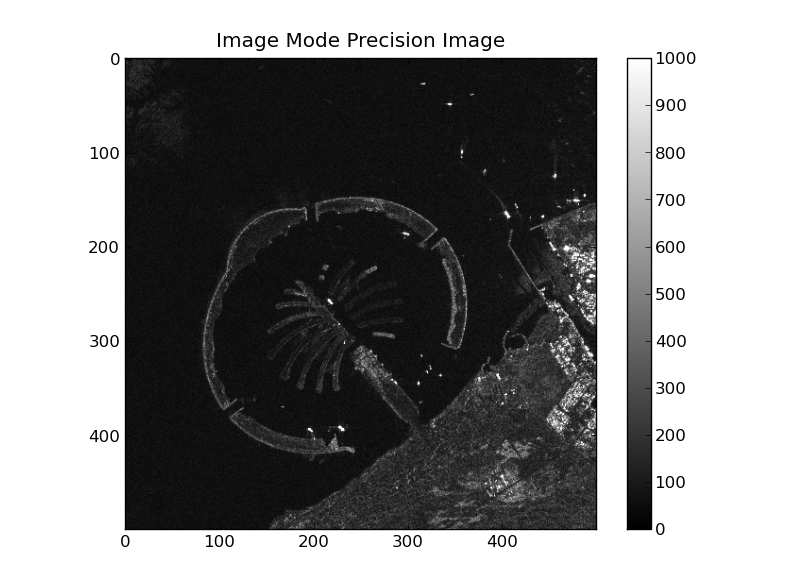Interactive use of PyEPR¶
In this tutorial it is showed an example of how to use PyEPR interactively to open, browse and display data of an ENVISAT ASAR product.
For the interactive session it is used the IPython interactive shell an started with the ipython -pylab option to enable interactive plotting provided by the matplotlib package.
The ASAR product used in this example is a free sample available at the ESA web site.
epr module and classes¶
After starting the ipython shell with the following command:
$ ipython -pylab
one can import the epr module and start start taking confidence with available classes and functions:
Python 2.6.6 (r266:84292, Sep 15 2010, 16:22:56)
Type "copyright", "credits" or "license" for more information.
IPython 0.10 -- An enhanced Interactive Python.
? -> Introduction and overview of IPython's features.
%quickref -> Quick reference.
help -> Python's own help system.
object? -> Details about 'object'. ?object also works, ?? prints more.
Welcome to pylab, a matplotlib-based Python environment.
For more information, type 'help(pylab)'.
In [1]: import epr
In [2]: epr?
Base Class: <type 'module'>
String Form: <module 'epr' from 'epr.so'>
Namespace: Interactive
File: /home/antonio/projects/pyepr/epr.so
Docstring:
Python bindings for ENVISAT Product Reader C API
PyEPR_ provides Python_ bindings for the ENVISAT Product Reader C API
(`EPR API`_) for reading satellite data from ENVISAT_ ESA_ (European
Space Agency) mission.
PyEPR_ is fully object oriented and, as well as the `EPR API`_ for C,
supports ENVISAT_ MERIS, AATSR Level 1B and Level 2 and also ASAR data
products. It provides access to the data either on a geophysical
(decoded, ready-to-use pixel samples) or on a raw data layer.
The raw data access makes it possible to read any data field contained
in a product file.
.. _PyEPR: http://avalentino.github.com/pyepr
.. _Python: http://www.python.org
.. _`EPR API`: https://github.com/bcdev/epr-api
.. _ENVISAT: http://envisat.esa.int
.. _ESA: http://earth.esa.int
In [3]: epr.__version__, epr.EPR_C_API_VERSION
Out[3]: ('0.7.1', '2.3dev')
Docstrings are available for almost all classes, methods and functions in the epr and they can be displayed using the help() python command or the ? IPython shortcut as showed above.
Also IPython provides a handy tab completion mechanism to automatically complete commands or to display available functions and classes:
In [4]: product = epr. [TAB]
epr.Band epr.E_TID_TIME
epr.__builtins__ epr.E_TID_UCHAR
epr.__class__ epr.E_TID_UINT
epr._CLib epr.E_TID_UNKNOWN
epr._close_api epr.E_TID_USHORT
epr.collections epr.Field
epr.create_bitmask_raster epr.__file__
epr.create_raster epr.__format__
epr.Dataset epr.__getattribute__
epr.data_type_id_to_str epr.get_data_type_size
epr.__delattr__ epr.get_sample_model_name
epr.__dict__ epr.get_scaling_method_name
epr.__doc__ epr.__hash__
epr.DSD epr.__init__
epr.EPR_C_API_VERSION epr.__name__
epr.EPRError epr.__new__
epr.EprObject epr.np
epr.EPRTime epr.open
epr.EPRValueError epr.__package__
epr.E_SMID_LIN epr.Product
epr.E_SMID_LOG epr.Raster
epr.E_SMID_NON epr.Record
epr.E_SMOD_1OF1 epr.__reduce__
epr.E_SMOD_1OF2 epr.__reduce_ex__
epr.E_SMOD_2OF2 epr.__repr__
epr.E_SMOD_2TOF epr.__revision__
epr.E_SMOD_3TOI epr.__setattr__
epr.E_TID_CHAR epr.__sizeof__
epr.E_TID_DOUBLE epr.so
epr.E_TID_FLOAT epr.__str__
epr.E_TID_INT epr.__subclasshook__
epr.E_TID_SHORT epr.sys
epr.E_TID_SPARE epr.__test__
epr.E_TID_STRING epr.__version__
Iterating over epr objects¶
epr.Record objects are also iterable so one can write code like the following:
In [18]: for field in record:
if field.get_num_elems() == 4:
print('%s: %d elements' % (field.get_name(), len(field)))
....:
nominal_chirp.1.nom_chirp_amp: 4 elements
nominal_chirp.1.nom_chirp_phs: 4 elements
nominal_chirp.2.nom_chirp_amp: 4 elements
nominal_chirp.2.nom_chirp_phs: 4 elements
nominal_chirp.3.nom_chirp_amp: 4 elements
nominal_chirp.3.nom_chirp_phs: 4 elements
nominal_chirp.4.nom_chirp_amp: 4 elements
nominal_chirp.4.nom_chirp_phs: 4 elements
nominal_chirp.5.nom_chirp_amp: 4 elements
nominal_chirp.5.nom_chirp_phs: 4 elements
beam_merge_sl_range: 4 elements
beam_merge_alg_param: 4 elements
Image data¶
Dealing with image data is simple as well:
In [19]: product.get_band_names()
Out[19]: ['slant_range_time',
'incident_angle',
'latitude',
'longitude',
'proc_data']
In [19]: band = product.get_band('proc_data')
In [20]: data = band. [TAB]
band.bm_expr band.read_as_array
band.__class__ band.read_raster
band.create_compatible_raster band.__reduce__
band.data_type band.__reduce_ex__
band.__delattr__ band.__repr__
band.description band.sample_model
band.__doc__ band.scaling_factor
band.__format__ band.scaling_method
band.__getattribute__ band.scaling_offset
band.get_name band.__setattr__
band.__hash__ band.__sizeof__
band.__init__ band.spectr_band_index
band.lines_mirrored band.__str__
band.__new__ band.__subclasshook__
band.product band.unit
band.__pyx_vtable__
In [20]: data = band.read_as_array(1000, 1000, xoffset=100, yoffset=6500, \
xstep=2, ystep=2)
In [21]: data
Out[21]:
array([[ 146., 153., 134., ..., 51., 55., 72.],
[ 198., 163., 146., ..., 26., 54., 57.],
[ 127., 205., 105., ..., 64., 76., 61.],
...,
[ 64., 78., 52., ..., 96., 176., 159.],
[ 66., 41., 45., ..., 200., 153., 203.],
[ 64., 71., 88., ..., 289., 182., 123.]], dtype=float32)
In [22]: data.shape
Out[22]: (500, 500)
In [23]: imshow(data, cmap=cm.gray, vmin=0, vmax=1000)
Out[23]: <matplotlib.image.AxesImage object at 0x60dcf10>
In [24]: title(band.description)
Out[24]: <matplotlib.text.Text object at 0x67e9950>
In [25]: colorbar()
Out[25]: <matplotlib.colorbar.Colorbar instance at 0x6b18cb0>

Image data read from the “proc_data” band